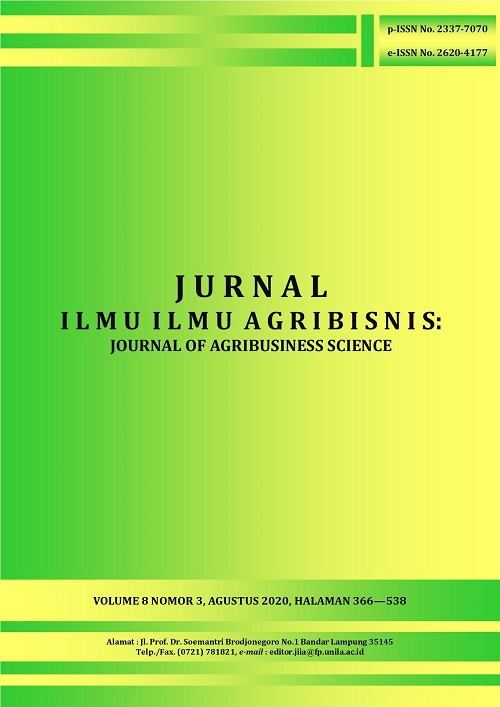PENGARUH PENERAPAN SISTEM TANAM HAZTON TERHADAP PRODUKTIVITAS DAN PENDAPATAN DI DESA PAREREJO KECAMATAN GADINGREJO KABUPATEN PRINGSEWU
DOI:
https://doi.org/10.23960/jiia.v8i3.4450 Abstract View: 419
Abstract View: 419
Abstract
This study aims to analyze the effects of the application of the hazton planting system on productivity and income, find out the comparison of the income of rice farmers with hazton planting system and conventional planting systems, analyze factors affecting rice farming production of hazton and conventional cropping system, and analyze factors affecting income from hazton rice farmeing and conventional cropping systems. Location was selected purposively in Parerejo Village, Gadingrejo Subdistrict, Pringsewu District. Respondents in this study were 30 rice farmers with hazton planting system and 30 rice farmers with conventional planting system. Data collection was conducted in October - November 2018. Data analysis methods used were qualitative and quantitative analyses. The results of this study indicated that the income of the hazton planting system does not significantly influence the application of the hazton planting system. There is a difference in income from the farming of hazton planting system and conventional planting system with a confidence level of 99 percent difference in income of IDR435,670. Factors that influence rice farming production with hazton planting system and conventional cropping system in Parerejo Village Gadingrejo Subdistrict, Pringsewu District are age, length of farming experience, and rice seeds, whereas, education, and land size do not influence the productivity of rice farming. Based on the analysis, the factors that influence the income of rice farming with the hazton planting system and conventional planting systems in the Parerejo Village Gadingrejo Subdistrict, Pringsewu Regency are education level, selling price, and seeds.
Key words: conventional planting system, hazton planting system, income.
Downloads
Downloads
Published
How to Cite
Issue
Section
License
Authors who publish with this journal agree to the following terms:
Authors retain copyright and grant the journal right of first publication with the work simultaneously licensed under a Creative Commons Attribution License that allows others to share the work with an acknowledgement of the work's authorship and initial publication in this journal.
Authors are able to enter into separate, additional contractual arrangements for the non-exclusive distribution of the journal's published version of the work (e.g., post it to an institutional repository or publish it in a book), with an acknowledgement of its initial publication in this journal.
Authors are permitted and encouraged to post their work online (e.g., in institutional repositories or on their website) prior to and during the submission process, as it can lead to productive exchanges, as well as earlier and greater citation of published work (See The Effect of Open Access).














